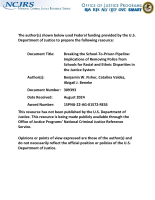Crime surveys
Research into Immigration and Crime: Advancing the Understanding of Immigration, Crime, and Crime Reporting at the Local Level with a Synthetic Population, Final Report
CRIME RATES, VICTIMS, OFFENDERS - A VICTIMIZATION STUDY
Crime Survey of Citizens in El Paso County: Victimization, Fear, and Perceptions of Police
Community Policing in Chicago, Year Two: An Interim Report
COMPASS A DRUG MARKET ANALYSIS PROGRAM, FINAL REPORT JANUARY, 1993 (HARTFORD)
Impact of Crime on Small Business Viability
Psychological Impact of Crime: A Study of Randomly Surveyed Crime Victims, Executive Summary
Neighborhoods and Disorder - Resistance and Accommodation Final Report
Commercial Security Field Test, Long Beach, California - Final Report
Gangs in North Carolina: A Summary of the Law Enforcement Survey
New Directions in Research on Immigration and Crime
Assessing Transgender Hate Crime Victimization and LGBTQ Liaison Unit Response
The Consequences and Impacts of Hate Crime and Post-Victimization Experiences: The Longitudinal Hate Crime Victimization Survey (LHCVS)
Breaking the School-To-Prison Pipeline: Implications of Removing Police from Schools for Racial and Ethnic Disparities in the Justice System
Understanding the Impact of COVID-19 on Victim Services
The COVID-19 pandemic had a detrimental impact on communities across the nation and significantly affected various aspects of individuals’ lives. One of the negative impacts was an increase in gender-based violence accompanied by shifting barriers to accessing services and support. Victims and victim service providers faced various challenges dealing with the increase in need for services, navigating barriers to help-seeking, and addressing logistical issues.
See the YouTube Terms of Service and Google Privacy Policy
SOCIAL CONSTRUCTION OF HATE CRIMES IN THE US: A FACTORIAL SURVEY EXPERIMENT
Neighborhood Crime Survey: An Examination of the Relationship between Immigration and Victimization
The Effects of Hot Spot Policing on Community Experiences and Perceptions in a Time of COVID-19 and Calls for Police Reform
Final Report: New Estimates of the Costs of Criminal Victimization
VICTIMIZATION SURVEYS AND CRIMINAL JUSTICE PLANNING
Breaking the School-to-Prison Pipeline: Implications of Removing Police from Schoolsfor Racial and Ethnic Disparities in the Justice System
Residential Burglary: A Comparison of the United States, Canada and England and Wales
Gun Theft and Crime
Multilevel Evaluation of Project Safe Neighborhoods
Project Safe Neighborhoods (PSN) is a DOJ-sponsored initiative to reduce violent crime, particularly gun crime, by fostering cooperation by criminal justice agencies and local partners to develop and implement strategic approaches.
See the YouTube Terms of Service and Google Privacy Policy





